A Common Symptom of Tarsal Tunnel Syndrome
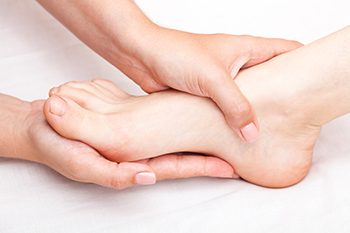 The tarsal tunnel is an area of the foot that is found below that ankle, and if it becomes inflamed as a result of an injury, tarsal tunnel syndrome may develop. This is caused by nerve that is located inside of the tarsal tunnel, called the tibial nerve, becoming pressed. A common symptom that is associated with this condition can consist of a burning sensation under the foot, and it could radiate to the toes and the heels. Walking may intensify this ailment, as it causes pressure to be put on the tibial nerve. If you have this type of pain, and it is hindering accomplishing daily activities, there are many options that are available for treatment. Please consult with a podiatrist who can recommend the best type of treatment for you.
The tarsal tunnel is an area of the foot that is found below that ankle, and if it becomes inflamed as a result of an injury, tarsal tunnel syndrome may develop. This is caused by nerve that is located inside of the tarsal tunnel, called the tibial nerve, becoming pressed. A common symptom that is associated with this condition can consist of a burning sensation under the foot, and it could radiate to the toes and the heels. Walking may intensify this ailment, as it causes pressure to be put on the tibial nerve. If you have this type of pain, and it is hindering accomplishing daily activities, there are many options that are available for treatment. Please consult with a podiatrist who can recommend the best type of treatment for you.
Tarsal tunnel syndrome can be very uncomfortable to live with. If you are experiencing tarsal tunnel syndrome, contact Dr. Joshua David Scoll of Pennsylvania. Our doctor can provide the care you need to keep you pain-free and on your feet.
Tarsal Tunnel Syndrome
Tarsal tunnel syndrome, which can also be called tibial nerve dysfunction, is an uncommon condition of misfiring peripheral nerves in the foot. The tibial nerve is the peripheral nerve in the leg responsible for sensation and movement of the foot and calf muscles. In tarsal tunnel syndrome, the tibial nerve is damaged, causing problems with movement and feeling in the foot of the affected leg.
Common Cause of Tarsal Tunnel Syndrome
- Involves pressure or an injury, direct pressure on the tibial nerve for an extended period of time, sometimes caused by other body structures close by or near the knee.
- Diseases that damage nerves, including diabetes, may cause tarsal tunnel syndrome.
- At times, tarsal tunnel syndrome can appear without an obvious cause in some cases.
The Effects of Tarsal Tunnel Syndrome
- Different sensations, an afflicted person may experience pain, tingling, burning or other unusual sensations in the foot of the affected leg.
- The foot muscles, toes and ankle become weaker, and curling your toes or flexing your foot can become difficult.
- If condition worsens, infections and ulcers may develop on the foot that is experiencing the syndrome.
A physical exam of the leg can help identify the presence of tarsal tunnel syndrome. Medical tests, such as a nerve biopsy, are also used to diagnose the condition. Patients may receive physical therapy and prescriptive medication. In extreme cases, some may require surgery.
If you have any questions please feel free to contact one of our offices located in Philadelphia, Bensalem, and Fairless Hills, PA . We offer the newest diagnostic and treatment technologies for all your foot and ankle needs.
Helpful Tips for Measuring Your Feet
Planning a trip to the shoe store? Be sure to start with an accurate measurement to ensure you get shoes that are the right size. Start at the end of the day when your feet are at their largest, and stand up straight with one foot on a piece of paper (tape two pieces together if necessary). Carefully trace your foot’s shape with a pen or pencil held at a 90 degree angle. For the length: use a ruler or measuring tape to measure the tracing from the length of your foot from the bottom of your heel to the tip of the longest toe. To measure the width of your foot, wrap a measuring tape around the widest part of your foot (be sure you are pressing down the full weight of your body as you do it). Repeat the entire measuring process on your other foot. Check the largest measurements you’ve recorded against an online shoe size measurement tool to determine your ideal shoe size (length) and width (regular, wide, or extra wide). For more tips on choosing shoes most appropriate for your particular foot size and shape, consult with a podiatrist.
Getting the right shoe size is an important part of proper foot health. Seek the assistance of Dr. Joshua David Scoll from Pennsylvania. Our doctor will provide the care you need to keep you pain-free and on your feet.
Getting the Right Shoe Size
There are many people who wear shoes that are the incorrect size, negatively affecting their feet and posture. Selecting the right shoes is not a difficult process, so long as you keep several things in mind when it comes to choosing the right pair.
- When visiting the shoe store, use the tools available to measure your foot.
- Be sure there is ‘wiggle room’. There should be about an inch between your toes and the tip of your shoes.
- Do not always assume you are the same size, as manufacturers run differently.
- Purchase shoes later in the day, as your feet swell as the day progresses.
- If a shoe is not comfortable, it is not suitable. Most shoes can’t be ‘broken in’, and comfort should be the ultimate goal when it comes to choosing the right pair of shoes
As our feet hold our body weight and keep us moving, it is important to treat them right. Picking the right pair of shoes can provide your feet comfort and mobility without pain.
If you have any questions, please feel free to contact one of our offices located in Philadelphia, Bensalem, and Fairless Hills, PA . We offer the newest diagnostic and treatment technologies for all your foot care needs.
What is an Acute Running Injury?
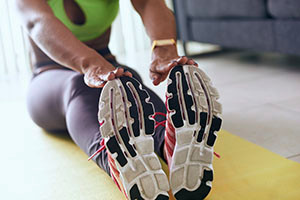 Research has indicated that a staggering sixty percent of people who enjoy running have endured a running injury in the past year. These injuries may be the result of inconsistent training and possibly from increasing speed and distance too soon. An acute running injury is generally traumatic and happens suddenly. Now you're probably wondering what an acute running injury is. Most commonly they are strains and sprains, but can also be a muscle tear, bone crack, or ligament snap. Other running injuries may include plantar fascitiis, heel spurs, stress fractures, ankle sprains, and Achilles tendonitis. Whether a runner falls, twists an ankle, or gets struck by a vehicle, it's usually painful and associated with a "popping" sound followed by inflammation. Additionally, the foot may have a limited range of motion, and it may be difficult to walk. Runners may be able to prevent these injuries by paying attention to the type of ground they’re running on, being aware of their surroundings, and stretching before and after a run. There are many painful foot conditions that can occur from running injuries, and it is strongly suggested that you consult with a podiatrist who can provide helpful suggestions on how to prevent running injuries.
Research has indicated that a staggering sixty percent of people who enjoy running have endured a running injury in the past year. These injuries may be the result of inconsistent training and possibly from increasing speed and distance too soon. An acute running injury is generally traumatic and happens suddenly. Now you're probably wondering what an acute running injury is. Most commonly they are strains and sprains, but can also be a muscle tear, bone crack, or ligament snap. Other running injuries may include plantar fascitiis, heel spurs, stress fractures, ankle sprains, and Achilles tendonitis. Whether a runner falls, twists an ankle, or gets struck by a vehicle, it's usually painful and associated with a "popping" sound followed by inflammation. Additionally, the foot may have a limited range of motion, and it may be difficult to walk. Runners may be able to prevent these injuries by paying attention to the type of ground they’re running on, being aware of their surroundings, and stretching before and after a run. There are many painful foot conditions that can occur from running injuries, and it is strongly suggested that you consult with a podiatrist who can provide helpful suggestions on how to prevent running injuries.
All runners should take extra precaution when trying to avoid injury. If you have any concerns about your feet, contact Dr. Joshua David Scoll of Pennsylvania. Our doctor will treat your foot and ankle needs.
How to Prevent Running Injuries
There are a lot of mistakes a runner can make prior to a workout that can induce injury. A lot of athletes tend to overstretch before running, instead of saving those workouts for a post-run routine. Deep lunges and hand-to-toe hamstring pulls should be performed after a workout instead of during a warmup. Another common mistake is jumping into an intense routine before your body is physically prepared for it. You should try to ease your way into long-distance running instead of forcing yourself to rush into it.
More Tips for Preventing Injury
- Incorporate Strength Training into Workouts - This will help improve the body’s overall athleticism
- Improve and Maintain Your Flexibility – Stretching everyday will help improve overall performance
- “Warm Up” Before Running and “Cool Down” Afterward – A warm up of 5-10 minutes helps get rid of lactic acid in the muscles and prevents delayed muscle soreness
- Cross-Training is Crucial
- Wear Proper Running Shoes
- Have a Formal Gait Analysis – Poor biomechanics can easily cause injury
If you have any questions, please feel free to contact one of our offices located in Philadelphia, Bensalem, and Fairless Hills, PA . We offer the newest diagnostic and treatment technologies for all your foot care needs.
Is There Relief for Bunions?
 The bottom and side of the big toe is generally the location where a bunion develops. It is considered to be a deformity and can appear for a variety of reasons. These can include genetic factors, and wearing shoes that do not have enough room for the toes to move freely in. Additionally, existing medical conditions such as gout or rheumatoid arthritis may cause a bunion to develop. If the bunion is mild relief may be found when orthotics are worn, or when the bunion is covered with a protective pad. Severe bunions may require surgery to correct them permanently. If you notice signs of a small bump on the side of the big toe, please confer with a podiatrist as quickly as possible. Early treatment can slow down or stop a bunion's progression.
The bottom and side of the big toe is generally the location where a bunion develops. It is considered to be a deformity and can appear for a variety of reasons. These can include genetic factors, and wearing shoes that do not have enough room for the toes to move freely in. Additionally, existing medical conditions such as gout or rheumatoid arthritis may cause a bunion to develop. If the bunion is mild relief may be found when orthotics are worn, or when the bunion is covered with a protective pad. Severe bunions may require surgery to correct them permanently. If you notice signs of a small bump on the side of the big toe, please confer with a podiatrist as quickly as possible. Early treatment can slow down or stop a bunion's progression.
If you are suffering from bunion pain, contact Dr. Joshua David Scoll of Pennsylvania. Our doctor can provide the care you need to keep you pain-free and on your feet.
What Is a Bunion?
Bunions are painful bony bumps that usually develop on the inside of the foot at the joint of the big toe. As the deformity increases over time, it may become painful to walk and wear shoes. Women are more likely to exacerbate existing bunions since they often wear tight, narrow shoes that shift their toes together. Bunion pain can be relieved by wearing wider shoes with enough room for the toes.
Causes
- Genetics – some people inherit feet that are more prone to bunion development
- Inflammatory Conditions - rheumatoid arthritis and polio may cause bunion development
Symptoms
- Redness and inflammation
- Pain and tenderness
- Callus or corns on the bump
- Restricted motion in the big toe
In order to diagnose your bunion, your podiatrist may ask about your medical history, symptoms, and general health. Your doctor might also order an x-ray to take a closer look at your feet. Nonsurgical treatment options include orthotics, padding, icing, changes in footwear, and medication. If nonsurgical treatments don’t alleviate your bunion pain, surgery may be necessary.
If you have any questions, please feel free to contact one of our offices located in Philadelphia, Bensalem, and Fairless Hills, PA . We offer the newest diagnostic and treatment technologies for all your foot care needs.
Risk Factors for Foot Stress Fractures
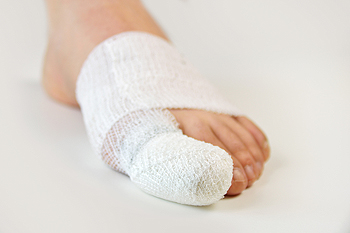 A stress fracture refers to a tiny crack in a bone that may happen when the bone can no longer bear the load placed on it. Foot stress fractures often affect athletes, who place a great deal of stress on their feet. Foot fractures also commonly affect women. This is thought to be due to fluctuating hormone levels weakening the bones. Teens are also at an increased risk of stress fractures, as they often have high activity levels and bones that are still in the process of growing. Osteoporosis, abnormal foot biomechanics, or having had a previous stress fracture can all make another stress fracture more likely to occur, as can wearing shoes that don't properly fit or support the foot. If you are experiencing pain, swelling, or tenderness in your foot, it is suggested that you seek the care of a podiatrist as soon as possible.
A stress fracture refers to a tiny crack in a bone that may happen when the bone can no longer bear the load placed on it. Foot stress fractures often affect athletes, who place a great deal of stress on their feet. Foot fractures also commonly affect women. This is thought to be due to fluctuating hormone levels weakening the bones. Teens are also at an increased risk of stress fractures, as they often have high activity levels and bones that are still in the process of growing. Osteoporosis, abnormal foot biomechanics, or having had a previous stress fracture can all make another stress fracture more likely to occur, as can wearing shoes that don't properly fit or support the foot. If you are experiencing pain, swelling, or tenderness in your foot, it is suggested that you seek the care of a podiatrist as soon as possible.
Stress fractures occur when there is a tiny crack within a bone. To learn more, contact Dr. Joshua David Scoll from Pennsylvania. Our doctor can provide the care you need to keep you pain free and on your feet.
How Are They Caused?
Stress fractures are the result of repetitive force being placed on the bone. Since the lower leg and feet often carry most of the body’s weight, stress fractures are likely to occur in these areas. If you rush into a new exercise, you are more likely to develop a stress fracture since you are starting too much, too soon. Pain resulting from stress fractures may go unnoticed at first, however it may start to worsen over time.
Risk Factors
- Gender – They are more commonly found in women compared to men.
- Foot Problems – People with unusual arches in their feet are more likely to develop stress fractures.
- Certain Sports – Dancers, gymnasts, tennis players, runners, and basketball players are more likely to develop stress fractures.
- Lack of Nutrients – A lack of vitamin D and calcium may weaken the bones and make you more prone to stress fractures
- Weak Bones – Osteoporosis can weaken the bones therefore resulting in stress fractures
Stress fractures do not always heal properly, so it is important that you seek help from a podiatrist if you suspect you may have one. Ignoring your stress fracture may cause it to worsen, and you may develop chronic pain as well as additional fractures.
If you have any questions, please feel free to contact one of our offices located in Philadelphia, Bensalem, and Fairless Hills, PA . We offer the newest diagnostic and treatment technologies for all your foot care needs.
Gout in the Big Toe
Gout is a type of arthritis caused by a buildup of uric acid in the bloodstream. Uric acid can crystallize and lodge in the joints, leading to painful gout flare ups. One of the most frequent sites for a gout flare up is the big toe joint. Gout in the big toe typically causes intense throbbing and burning joint pain, which occurs with a sudden onset, often in the middle of the night. The pain may be accompanied by swelling, tenderness, warmth, and redness, as well as difficulty moving the big toe. All of this can interfere with walking or standing and going about your daily activities. Gout may flare up once, or could become a chronic condition and lead to permanent joint damage. If you have experienced a gout flare up in your big toe or anywhere else in your feet, it is suggested that you are under the care of a podiatrist.
Gout is a foot condition that requires certain treatment and care. If you are seeking treatment, contact Dr. Joshua David Scoll from Pennsylvania. Our doctor will treat your foot and ankle needs.
What Is Gout?
Gout is a type of arthritis caused by a buildup of uric acid in the bloodstream. It often develops in the foot, especially the big toe area, although it can manifest in other parts of the body as well. Gout can make walking and standing very painful and is especially common in diabetics and the obese.
People typically get gout because of a poor diet. Genetic predisposition is also a factor. The children of parents who have had gout frequently have a chance of developing it themselves.
Gout can easily be identified by redness and inflammation of the big toe and the surrounding areas of the foot. Other symptoms include extreme fatigue, joint pain, and running high fevers. Sometimes corticosteroid drugs can be prescribed to treat gout, but the best way to combat this disease is to get more exercise and eat a better diet.
If you have any questions please feel free to contact one of our offices located in Philadelphia, Bensalem, and Fairless Hills, PA . We offer the newest diagnostic and treatment technologies for all your foot and ankle needs.
The Effects of Excessively Sweaty Feet
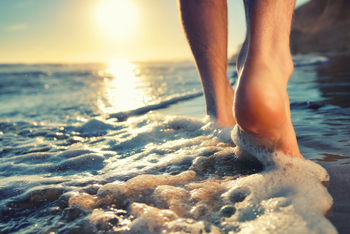 Plantar hyperhidrosis is a medical condition that causes the feet to sweat excessively. An overabundance of sweat can make the skin of the feet break down, become pale and wrinkled, red and inflamed, or cracked. The feet may also emit a foul odor as sweat is broken down by bacteria. Excessive sweat can ruin shoes and socks, make you more likely to slip and fall, and be embarrassing in public. Fortunately, plantar hyperhidrosis can be treated effectively. Antiperspirants can be prescribed and applied directly to the skin to reduce sweating. Iontophoresis and botox injections into the feet are two other potential solutions. If you have excessively sweaty feet, it is suggested that you consult with a podiatrist to find the right treatment for you.
Plantar hyperhidrosis is a medical condition that causes the feet to sweat excessively. An overabundance of sweat can make the skin of the feet break down, become pale and wrinkled, red and inflamed, or cracked. The feet may also emit a foul odor as sweat is broken down by bacteria. Excessive sweat can ruin shoes and socks, make you more likely to slip and fall, and be embarrassing in public. Fortunately, plantar hyperhidrosis can be treated effectively. Antiperspirants can be prescribed and applied directly to the skin to reduce sweating. Iontophoresis and botox injections into the feet are two other potential solutions. If you have excessively sweaty feet, it is suggested that you consult with a podiatrist to find the right treatment for you.
If you are suffering from hyperhidrosis contact Dr. Joshua David Scoll of Pennsylvania. Our doctor can provide the care you need to attend to all of your foot and ankle needs.
Hyperhidrosis of the Feet
Hyperhidrosis is a rare disorder that can cause people to have excessive sweating of their feet. This can usually occur all on its own without rigorous activity involved. People who suffer from hyperhidrosis may also experience sweaty palms.
Although it is said that sweating is a healthy process meant to cool down the body temperature and to maintain a proper internal temperature, hyperhidrosis may prove to be a huge hindrance on a person’s everyday life.
Plantar hyperhidrosis is considered to be the main form of hyperhidrosis. Secondary hyperhidrosis can refer to sweating that occurs in areas other than the feet or hands and armpits. Often this may be a sign of it being related to another medical condition such as menopause, hyperthyroidism and even Parkinson’s disease.
In order to alleviate this condition, it is important to see your doctor so that they may prescribe the necessary medications so that you can begin to live a normal life again. If this is left untreated, it is said that it will persist throughout an individual’s life.
A last resort approach would be surgery, but it is best to speak with your doctor to find out what may be the best treatment for you.
If you have any questions please feel free to contact one of our offices located in Philadelphia, Bensalem, and Fairless Hills, PA . We offer the newest diagnostic and treatment technologies for all your foot and ankle needs.
My Child's Foot Is Asleep
Foot numbness in children is frequently caused by a compression of the nerves in the foot following a period of sitting with the legs or feet tucked underneath the body. The term for this is the foot “falling asleep.” Though your child may feel a pins and needles sensation, heaviness, or pain in their feet upon standing, this is nothing to worry about and tends to go away within minutes as the foot “wakes up.” Nevertheless, there are other possible causes of foot numbness, such as injuries to the feet or ankles, that you should watch out for. If your child complains of frequent foot pain or numbness that interferes with their daily activities or gets worse over time, it is suggested that you take your child to see a podiatrist.
The health of a child’s feet is vital to their overall well-being. If you have any questions regarding foot health, contact Dr. Joshua David Scoll of Pennsylvania. Our doctor can provide the care you need to keep you pain-free and on your feet.
Tips for Keeping Children's Feet Healthy
- Make sure their shoes fit properly
- Look for any signs of in-toeing or out-toeing
- Check to see if they have Clubfoot (condition that affects your child’s foot and ankle, twisting the heel and toes inward) which is one of the most common nonmajor birth defects.
- Lightly cover your baby’s feet (Tight covers may keep your baby from moving their feet freely, and could prevent normal development)
- Allow your toddler to go shoeless (Shoes can be restricting for a young child’s foot)
- Cut toenails straight across to avoid ingrown toenails
- Keep your child’s foot clean and dry
- Cover cuts and scrapes. Wash any scratches with soap and water and cover them with a bandage until they’ve healed.
If you have any questions, please feel free to contact one of our offices located in Philadelphia, Bensalem, and Fairless Hills, PA . We offer the newest diagnostic and treatment technologies for all your foot care needs.
Why Are My Feet Flat?
 If your feet have no visible arch when standing, you’re not alone. Flat feet are common, affecting an estimated 12% of the US population. The majority of infants are born with flat feet and have an arch that develops over time. However, this does not happen for everyone. For reasons that are currently unknown, but that likely have to do with genetics and environmental factors, some people never develop an arch. It is also possible to develop an arch normally and then lose it over time. This collapse of an existing arch is known as acquired flat foot or fallen arches and is thought to be caused by the aging process and a degeneration of the tissues that support the foot and ankle. Acquired flat foot has also been linked to pregnancy. While feet that are flat from birth usually don’t cause any pain or discomfort, acquired flat feet often do. If you are experiencing any foot pain, it is suggested that you seek the care of a podiatrist.
If your feet have no visible arch when standing, you’re not alone. Flat feet are common, affecting an estimated 12% of the US population. The majority of infants are born with flat feet and have an arch that develops over time. However, this does not happen for everyone. For reasons that are currently unknown, but that likely have to do with genetics and environmental factors, some people never develop an arch. It is also possible to develop an arch normally and then lose it over time. This collapse of an existing arch is known as acquired flat foot or fallen arches and is thought to be caused by the aging process and a degeneration of the tissues that support the foot and ankle. Acquired flat foot has also been linked to pregnancy. While feet that are flat from birth usually don’t cause any pain or discomfort, acquired flat feet often do. If you are experiencing any foot pain, it is suggested that you seek the care of a podiatrist.
Flatfoot is a condition many people suffer from. If you have flat feet, contact Dr. Joshua David Scoll from Pennsylvania. Our doctor will treat your foot and ankle needs.
What Are Flat Feet?
Flatfoot is a condition in which the arch of the foot is depressed and the sole of the foot is almost completely in contact with the ground. About 20-30% of the population generally has flat feet because their arches never formed during growth.
Conditions & Problems:
Having flat feet makes it difficult to run or walk because of the stress placed on the ankles.
Alignment – The general alignment of your legs can be disrupted, because the ankles move inward which can cause major discomfort.
Knees – If you have complications with your knees, flat feet can be a contributor to arthritis in that area.
Symptoms
- Pain around the heel or arch area
- Trouble standing on the tip toe
- Swelling around the inside of the ankle
- Flat look to one or both feet
- Having your shoes feel uneven when worn
Treatment
If you are experiencing pain and stress on the foot you may weaken the posterior tibial tendon, which runs around the inside of the ankle.
If you have any questions please feel free to contact one of our offices located in Philadelphia, Bensalem, and Fairless Hills, PA . We offer the newest diagnostic and treatment technologies for all your foot and ankle needs.
Controlling Blood Sugar Levels
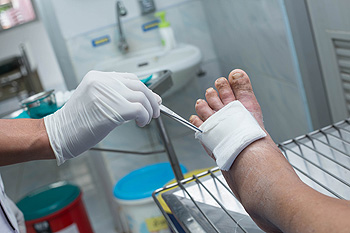 Patients who are diabetic can suffer from foot problems. These can include a variety of ailments, including foot ulcers, neuropathy, and bone deformities. Diabetes can happen as a result of elevated blood sugar levels, and it is important to keep blood sugar levels regulated. Minor cuts, scrapes, and bruises can lead to major complications, and the healing process is often delayed. If a foot ulcer has developed, it is important to keep any weight off of the affected foot, as this can help to accelerate healing. If you are diabetic, it is strongly suggested that you regularly have podiatric visits. Podiatrists can help you to manage this condition and its effects on your feet.
Patients who are diabetic can suffer from foot problems. These can include a variety of ailments, including foot ulcers, neuropathy, and bone deformities. Diabetes can happen as a result of elevated blood sugar levels, and it is important to keep blood sugar levels regulated. Minor cuts, scrapes, and bruises can lead to major complications, and the healing process is often delayed. If a foot ulcer has developed, it is important to keep any weight off of the affected foot, as this can help to accelerate healing. If you are diabetic, it is strongly suggested that you regularly have podiatric visits. Podiatrists can help you to manage this condition and its effects on your feet.
Diabetic foot care is important in preventing foot ailments such as ulcers. If you are suffering from diabetes or have any other concerns about your feet, contact Dr. Joshua David Scoll from Pennsylvania. Our doctor can provide the care you need to keep you pain-free and on your feet.
Diabetic Foot Care
Diabetes affects millions of people every year. The condition can damage blood vessels in many parts of the body, especially the feet. Because of this, taking care of your feet is essential if you have diabetes, and having a podiatrist help monitor your foot health is highly recommended.
The Importance of Caring for Your Feet
- Routinely inspect your feet for bruises or sores.
- Wear socks that fit your feet comfortably.
- Wear comfortable shoes that provide adequate support.
Patients with diabetes should have their doctor monitor their blood levels, as blood sugar levels play such a huge role in diabetic care. Monitoring these levels on a regular basis is highly advised.
It is always best to inform your healthcare professional of any concerns you may have regarding your feet, especially for diabetic patients. Early treatment and routine foot examinations are keys to maintaining proper health, especially because severe complications can arise if proper treatment is not applied.
If you have any questions please feel free to contact one of our offices located in Philadelphia, Bensalem, and Fairless Hills, PA . We offer the newest diagnostic and treatment technologies for all your foot and ankle needs.
When to Visit a Podiatrist for Ankle Pain
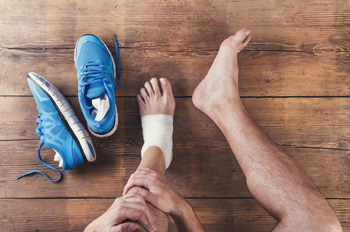 The ankle is a network of bones, ligaments, and tendons that is designed to bear the weight of the body and allow for movement. Common causes of ankle pain include a sprained ankle, stress fracture, tarsal tunnel syndrome, arthritis, Achilles tendonitis, as well as a variety of other conditions. Patients who are experiencing ankle pain should consult with their podiatrist immediately if the pain and swelling is severe, there is a severe open wound or deformity, there is a sign of infection, or the ankle cannot bear any weight. Patients with less severe injuries should consult with a podiatrist if their swelling has been persistent for 2-5 days, or their pain hasn’t improved after several weeks. A podiatrist will be able to properly diagnose and treat the condition according to each individual situation.
The ankle is a network of bones, ligaments, and tendons that is designed to bear the weight of the body and allow for movement. Common causes of ankle pain include a sprained ankle, stress fracture, tarsal tunnel syndrome, arthritis, Achilles tendonitis, as well as a variety of other conditions. Patients who are experiencing ankle pain should consult with their podiatrist immediately if the pain and swelling is severe, there is a severe open wound or deformity, there is a sign of infection, or the ankle cannot bear any weight. Patients with less severe injuries should consult with a podiatrist if their swelling has been persistent for 2-5 days, or their pain hasn’t improved after several weeks. A podiatrist will be able to properly diagnose and treat the condition according to each individual situation.
Ankle pain can have many different causes and the pain may potentially be serious. If you have ankle pain, consult with Dr. Joshua David Scoll from Pennsylvania. Our doctor will assess your condition and provide you with quality foot and ankle treatment.
Ankle pain is any condition that causes pain in the ankle. Due to the fact that the ankle consists of tendons, muscles, bones, and ligaments, ankle pain can come from a number of different conditions.
Causes
The most common causes of ankle pain include:
- Types of arthritis (rheumatoid, osteoarthritis, and gout)
- Ankle sprains
- Broken ankles
- Achilles tendinitis
- Achilles tendon rupture
- Stress fractures
- Tarsal tunnel syndrome
- Plantar fasciitis
Symptoms
Symptoms of ankle injury vary based upon the condition. Pain may include general pain and discomfort, swelling, aching, redness, bruising, burning or stabbing sensations, and/or loss of sensation.
Diagnosis
Due to the wide variety of potential causes of ankle pain, podiatrists will utilize a number of different methods to properly diagnose ankle pain. This can include asking for personal and family medical histories and of any recent injuries. Further diagnosis may include sensation tests, a physical examination, and potentially x-rays or other imaging tests.
Treatment
Just as the range of causes varies widely, so do treatments. Some more common treatments are rest, ice packs, keeping pressure off the foot, orthotics and braces, medication for inflammation and pain, and surgery.
If you have any questions, please feel free to contact one of our offices located in Philadelphia, Bensalem, and Fairless Hills, PA . We offer the newest diagnostic and treatment technologies for all your foot care needs.
How Did I Get an Ingrown Toenail?
 An ingrown toenail is defined by the toenail growing into the skin instead of over it. It can cause severe pain and discomfort, and it can easily become infected if it is not promptly treated. One of the causes of developing this condition can be genetic factors, and curved or thick nails may lead to ingrown toenails. Additionally, wearing shoes that do not have adequate room for the toes to move freely in may cause this ailment to occur. Some patients have found mild relief when the affected toe is soaked in warm water, and this can help to soften the skin which may allow the skin to be pushed away from the nail. It is strongly suggested that you are under the care of a podiatrist who can help you with correct treatment options.
An ingrown toenail is defined by the toenail growing into the skin instead of over it. It can cause severe pain and discomfort, and it can easily become infected if it is not promptly treated. One of the causes of developing this condition can be genetic factors, and curved or thick nails may lead to ingrown toenails. Additionally, wearing shoes that do not have adequate room for the toes to move freely in may cause this ailment to occur. Some patients have found mild relief when the affected toe is soaked in warm water, and this can help to soften the skin which may allow the skin to be pushed away from the nail. It is strongly suggested that you are under the care of a podiatrist who can help you with correct treatment options.
Ingrown toenails may initially present themselves as a minor discomfort, but they may progress into an infection in the skin without proper treatment. For more information about ingrown toenails, contact Dr. Joshua David Scoll of Pennsylvania. Our doctor can provide the care you need to keep you pain-free and on your feet.
Ingrown Toenails
Ingrown toenails are caused when the corner or side of a toenail grows into the soft flesh surrounding it. They often result in redness, swelling, pain, and in some cases, infection. This condition typically affects the big toe and may recur if it is not treated properly.
Causes
- Improper toenail trimming
- Genetics
- Improper shoe fitting
- Injury from pedicures or nail picking
- Abnormal gait
- Poor hygiene
You are more likely to develop an ingrown toenail if you are obese, have diabetes, arthritis, or have any fungal infection in your nails. Additionally, people who have foot or toe deformities are at a higher risk of developing an ingrown toenail.
Symptoms
Some symptoms of ingrown toenails are redness, swelling, and pain. In rare cases, there may be a yellowish drainage coming from the nail.
Treatment
Ignoring an ingrown toenail can have serious complications. Infections of the nail border can progress to a deeper soft-tissue infection, which can then turn into a bone infection. You should always speak with your podiatrist if you suspect you have an ingrown toenail, especially if you have diabetes or poor circulation.
If you have any questions, please feel free to contact one of our offices located in Philadelphia, Bensalem, and Fairless Hills, PA . We offer the newest diagnostic and treatment technologies for all your foot care needs.
More...
Many Reasons Why Heel Pain Can Develop
 Many people who enjoy running are prone to developing heel pain. A common cause of this type of pain is plantar fasciitis and soft tissue pain. Additionally, joint pain in the ankle may cause heel pain, and it may be difficult to achieve full range of motion.This can affect the cartilage, which may lead to osteoarthritis and ultimately cause heel pain. An overlooked reason why heel pain can develop may center around the nerves in the feet, which if damaged, can cause severe pain and discomfort. If you are experiencing any type of heel pain, it is suggested that you speak to a podiatrist who can accurately diagnose the source of the pain, and offer correct treatment solutions.
Many people who enjoy running are prone to developing heel pain. A common cause of this type of pain is plantar fasciitis and soft tissue pain. Additionally, joint pain in the ankle may cause heel pain, and it may be difficult to achieve full range of motion.This can affect the cartilage, which may lead to osteoarthritis and ultimately cause heel pain. An overlooked reason why heel pain can develop may center around the nerves in the feet, which if damaged, can cause severe pain and discomfort. If you are experiencing any type of heel pain, it is suggested that you speak to a podiatrist who can accurately diagnose the source of the pain, and offer correct treatment solutions.
Many people suffer from bouts of heel pain. For more information, contact Dr. Joshua David Scoll of Pennsylvania. Our doctor can provide the care you need to keep you pain-free and on your feet.
Causes of Heel Pain
Heel pain is often associated with plantar fasciitis. The plantar fascia is a band of tissues that extends along the bottom of the foot. A rip or tear in this ligament can cause inflammation of the tissue.
Achilles tendonitis is another cause of heel pain. Inflammation of the Achilles tendon will cause pain from fractures and muscle tearing. Lack of flexibility is also another symptom.
Heel spurs are another cause of pain. When the tissues of the plantar fascia undergo a great deal of stress, it can lead to ligament separation from the heel bone, causing heel spurs.
Why Might Heel Pain Occur?
- Wearing ill-fitting shoes
- Wearing non-supportive shoes
- Weight change
- Excessive running
Treatments
Heel pain should be treated as soon as possible for immediate results. Keeping your feet in a stress-free environment will help. If you suffer from Achilles tendonitis or plantar fasciitis, applying ice will reduce the swelling. Stretching before an exercise like running will help the muscles. Using all these tips will help make heel pain a condition of the past.
If you have any questions please contact one of our offices located in Philadelphia, Bensalem, and Fairless Hills, PA . We offer the newest diagnostic and treatment technologies for all your foot and ankle needs.
Treatment for Hammertoe
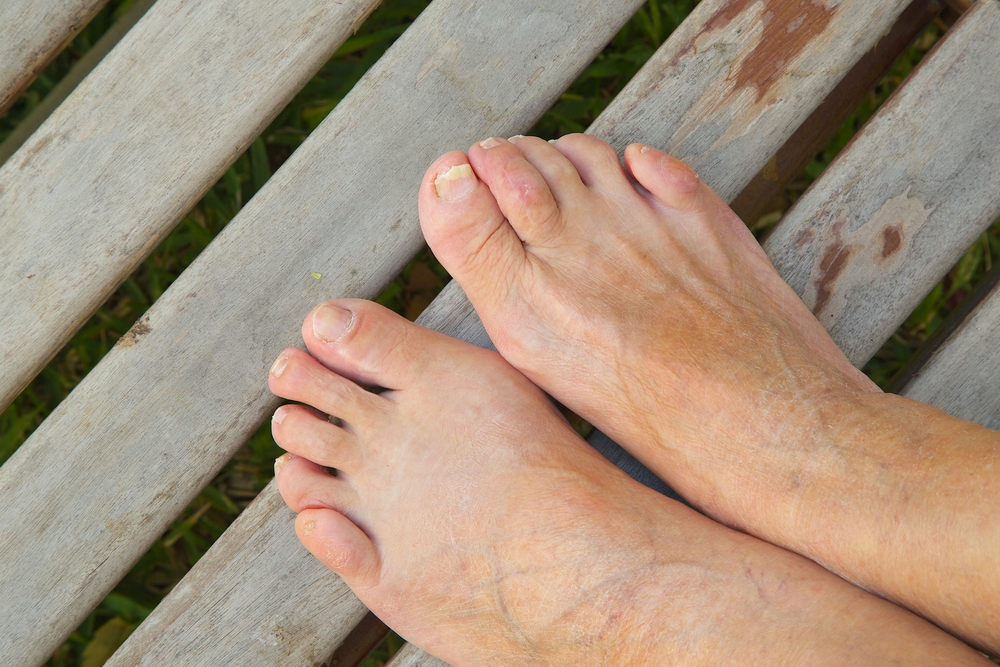 Hammertoe is a type of foot deformity in which the toes bend upward at the middle joint, giving them a hammer-like appearance. This condition is usually caused by a muscle or tendon imbalance, but can be aggravated by wearing shoes that are too tight or narrow in the front or have excessively high heels. In the initial stages, the hammertoe may still be flexible and the toes can be straightened. In later stages, the toes can become rigid and you will not be able to straighten them. Flexible hammertoe can be treated by wearing shoes that are comfortable and have a wide toe box, wearing orthotic inserts, and stretching and exercising the toes. Rigid hammertoe may require surgery to correct it. If you have hammertoe, please consult with a podiatrist to see which treatment options may be right for you.
Hammertoe is a type of foot deformity in which the toes bend upward at the middle joint, giving them a hammer-like appearance. This condition is usually caused by a muscle or tendon imbalance, but can be aggravated by wearing shoes that are too tight or narrow in the front or have excessively high heels. In the initial stages, the hammertoe may still be flexible and the toes can be straightened. In later stages, the toes can become rigid and you will not be able to straighten them. Flexible hammertoe can be treated by wearing shoes that are comfortable and have a wide toe box, wearing orthotic inserts, and stretching and exercising the toes. Rigid hammertoe may require surgery to correct it. If you have hammertoe, please consult with a podiatrist to see which treatment options may be right for you.
Hammertoes can be a painful condition to live with. For more information, contact Dr. Joshua David Scoll of Pennsylvania. Our doctor will answer any of your foot- and ankle-related questions.
Hammertoe
Hammertoe is a foot deformity that occurs due to an imbalance in the muscles, tendons, or ligaments that normally hold the toe straight. It can be caused by the type of shoes you wear, your foot structure, trauma, and certain disease processes.
Symptoms
- Painful and/or difficult toe movement
- Swelling
- Joint stiffness
- Calluses/Corns
- Physical deformity
Risk Factors
- Age – The risk of hammertoe increases with age
- Sex – Women are more likely to have hammertoe compared to men
- Toe Length – You are more likely to develop hammertoe if your second toe is longer than your big toe
- Certain Diseases – Arthritis and diabetes may make you more likely to develop hammertoe
Treatment
If you have hammertoe, you should change into a more comfortable shoe that provides enough room for your toes. Exercises such as picking up marbles may strengthen and stretch your toe muscles. Nevertheless, it is important to seek assistance from a podiatrist in order to determine the severity of your hammertoe and see which treatment option will work best for you.
If you have any questions, please feel free to contact one of our offices located in Philadelphia, Bensalem, and Fairless Hills, PA . We offer the newest diagnostic and treatment technologies for all your foot care needs.
Why Does My Arch Go Away When I Stand?
While there are several different types of flatfoot, all of them involve a loss of the arch—either partial or total. Flexible flatfoot is a common form of this condition where the arch collapses upon standing and returns to normal when there is no weight on the foot. Because having flat feet changes the alignment of the foot (toes point outwardly, the heel points toward the outside of the foot, and the ankle turns in), people with this condition may be more prone to developing bunions and hammertoes. Flexible flatfoot may cause pain in various areas of the foot including the arch, heel, ankle, shin bone, or on the lateral side of the foot. Additionally, there may be some pain in the knee, hip, or lower back, and overall fatigue or aching in the feet or legs. A podiatrist can diagnose flatfoot through an examination and by taking an X-ray. Non-surgical treatment may involve shoe modifications, physical therapy, losing weight, modifying activities, or even wearing ankle or foot orthoses to help support your arches and adjust your gait. For a proper diagnosis and to determine what treatment option is best for you, it is suggested that you visit a podiatrist.
Flatfoot is a condition many people suffer from. If you have flat feet, contact Dr. Joshua David Scoll from Pennsylvania. Our doctor will treat your foot and ankle needs.
What Are Flat Feet?
Flatfoot is a condition in which the arch of the foot is depressed and the sole of the foot is almost completely in contact with the ground. About 20-30% of the population generally has flat feet because their arches never formed during growth.
Conditions & Problems:
Having flat feet makes it difficult to run or walk because of the stress placed on the ankles.
Alignment – The general alignment of your legs can be disrupted, because the ankles move inward which can cause major discomfort.
Knees – If you have complications with your knees, flat feet can be a contributor to arthritis in that area.
Symptoms
- Pain around the heel or arch area
- Trouble standing on the tip toe
- Swelling around the inside of the ankle
- Flat look to one or both feet
- Having your shoes feel uneven when worn
Treatment
If you are experiencing pain and stress on the foot you may weaken the posterior tibial tendon, which runs around the inside of the ankle.
If you have any questions please feel free to contact one of our offices located in Philadelphia, Bensalem, and Fairless Hills, PA . We offer the newest diagnostic and treatment technologies for all your foot and ankle needs.
Can Athlete's Foot Be Prevented?
 A skin infection that develops on the foot is often referred to as athlete’s foot. It is caused by a fungus, and can develop into an uncomfortable foot condition. This type of fungus is often found in warm and moist environments, consisting of public swimming pools, shower room floors, and surrounding areas. Common symptoms of athlete’s foot can include redness, itchy skin between the toes and on the sole of the foot, and the skin may become dry and begin to flake. Additionally, it can affect the toenails, which may turn yellow and become thick. It is considered to be contagious, and it is suggested that preventive methods are used while in these types of areas. These can include wearing appropriate shoes, and refraining from sharing towels and socks. If you notice symptoms of athlete’s foot, please consult with a podiatrist who can guide you toward the proper treatment techniques.
A skin infection that develops on the foot is often referred to as athlete’s foot. It is caused by a fungus, and can develop into an uncomfortable foot condition. This type of fungus is often found in warm and moist environments, consisting of public swimming pools, shower room floors, and surrounding areas. Common symptoms of athlete’s foot can include redness, itchy skin between the toes and on the sole of the foot, and the skin may become dry and begin to flake. Additionally, it can affect the toenails, which may turn yellow and become thick. It is considered to be contagious, and it is suggested that preventive methods are used while in these types of areas. These can include wearing appropriate shoes, and refraining from sharing towels and socks. If you notice symptoms of athlete’s foot, please consult with a podiatrist who can guide you toward the proper treatment techniques.
Athlete’s Foot
Athlete’s foot is often an uncomfortable condition to experience. Thankfully, podiatrists specialize in treating athlete’s foot and offer the best treatment options. If you have any questions about athlete’s foot, consult with Dr. Joshua David Scoll from Pennsylvania. Our doctor will assess your condition and provide you with quality treatment.
What Is Athlete’s Foot?
Tinea pedis, more commonly known as athlete’s foot, is a non-serious and common fungal infection of the foot. Athlete’s foot is contagious and can be contracted by touching someone who has it or infected surfaces. The most common places contaminated by it are public showers, locker rooms, and swimming pools. Once contracted, it grows on feet that are left inside moist, dark, and warm shoes and socks.
Prevention
The most effective ways to prevent athlete’s foot include:
- Thoroughly washing and drying feet
- Avoid going barefoot in locker rooms and public showers
- Using shower shoes in public showers
- Wearing socks that allow the feet to breathe
- Changing socks and shoes frequently if you sweat a lot
Symptoms
Athlete’s foot initially occurs as a rash between the toes. However, if left undiagnosed, it can spread to the sides and bottom of the feet, toenails, and if touched by hand, the hands themselves. Symptoms include:
- Redness
- Burning
- Itching
- Scaly and peeling skin
Diagnosis and Treatment
Diagnosis is quick and easy. Skin samples will be taken and either viewed under a microscope or sent to a lab for testing. Sometimes, a podiatrist can diagnose it based on simply looking at it. Once confirmed, treatment options include oral and topical antifungal medications.
If you have any questions, please feel free to contact one of our offices located in Philadelphia, Bensalem, and Fairless Hills, PA . We offer the newest diagnostic and treatment technologies for all your foot care needs.








